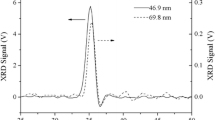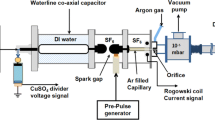Abstract.
Single-mode operation at the Au-II 690-nm transition was obtained in a segmented hollow-cathode discharge laser without the use of any additional frequency-selective device. The pressure of the helium buffer gas, which is responsible for the significant homogeneous broadening of the laser line, was varied between 10 and 20 mbar. The discharge was excited with rectangular current pulses (up to 3 A) six times exceeding the threshold value. The time dependence of the laser output during the 1-ms-long discharge pulses is explained on the basis of the temperature and pressure changes in the tube. The highest small-signal gain at optimal discharge conditions was 11%m−1.
Similar content being viewed by others
Author information
Authors and Affiliations
Additional information
Received: 1 July 1999 / Revised version: 4 November 1999 / Published online: 23 February 2000
Rights and permissions
About this article
Cite this article
Bánó, G., Szalai, L., Kutasi, K. et al. Operation characteristics of the Au-II 690-nm laser transition in a segmented hollow-cathode discharge. Appl Phys B 70, 521–525 (2000). https://doi.org/10.1007/s003400050855
Issue Date:
DOI: https://doi.org/10.1007/s003400050855




